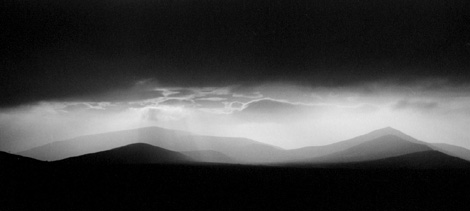

Since then, multi-graded papers have continued to improve and now we have a wide range of papers, made by various manufacturers, from which to choose. Agfa have now added to their range Multicontrast Classic Fine Grained Matt, a fibre based VC paper with a fine stipple matt surface similar to Portriga Rapid, one of Agfa's old traditional papers. I was most interested to see if Agfa had maintained the standards that they have previously set for multi-graded papers.

Moorstown Church, New Jersey, from a selenium toned Agfa Multicontrast Classic Fine Grained Matt Print.
An LPL diffusion colour enlarger and below-the-lens Agfa filters were used to provide the grades required for the test. I also used a Zone VI Cold Cathode Variable Contrast Enlarger to compare the relative contrast of the final results with those of the traditional method of filtration.
I used Kodak Multigrade Print Developer and my normal stop and fix baths to process Fine Grained Matt. The prints were developed for three minutes and stopped and fixed as normal. To test for safelight fog I exposed a sheet after pre-flashing, about 5 feet from an Encapsulite A10 safelight for 12 minutes and found no trace of fogging. The image is fairly slow in appearing in the developer but development does speed up in the final minute and I found no problems in controlling the tonality required in the final print. A densitometer test read the maximum black at less than 1.5 - visually, not as dark as an ordinary gloss RC print. This is however very misleading as the black looks only marginally weaker tha the gloss FB. CONTRAST RANGE I found that when exposed through Agfa's below-the-lens filters Fine Grained Matt was slightly harder in the soft and mid grades than when using Agfa dial-in filtration factors. However, grade 5 with below-the-lens filtration was considerably harder than the dial-in filtration. There was no instruction leaflet enclosed in the box so I assumed that the dial in filtration factors were the same as Multicontrast Classic Glossy.
In fact, a print made on glossy did produce the same results when compared with the Fine Grained Matt. I did not test the paper with other manufacturers' filters because I believe that the best results cannot be obtained from any of the multi-graded papers when using filters that are not designed to be compatible with the paper. Therefore, I would suggest that you always use the filters designed for use with the paper that you prefer.
If, like me, you use several papers to achieve different results I realise that will mean that you have to stock several sets of filters, or alternatively work out your own filtration factors for use on a colour head enlarger.
All fibre papers are subject to 'drydown' darkening. One of the most common problems that I encounter when I give workshops is the failure to take drydown into account when making the final print. When wet, the print looks bright and the highlights glow but the dried print is dull by comparison with degraded whites and sometimes blocked and dead shadows. This is the result of the drydown factor. Consequently, whenever I test a new paper I work out the drydown factor before making finished prints.
The procedure is simple; you make a print with the delicate highlights as you require them when wet. You then make a series of prints where the exposure is reduced by one second for each succeeding print, usually three will be sufficient. The first print is left wet and the remainder are dried and compared to the wet first print. The dried print that is the same in tonality as the wet print is the result that you look at. Deduct the exposure time of this print from the exposure time for the first print and work out as a percentage of the first exposure. This will be your drydown factor for that paper, and in future when assessing the wet test strip this figure is deducted from the exposure time chosen to give you the wet result. For example, if the first exposure is 10 seconds and the correct dried print is 9 seconds, the difference is 1 second therefore the drydown factor will be 10 per cent. This test takes a relatively short time and I would strongly recommend that you do it, especially if using fibre paper.
As a matter of interest, RC paper generally does not dry down very much when compared with fibre paper. Using the method described, I found that the drydown factor for Fine Grained Matt was 11 per cent.
I used selenium toner diluted 1 to 6 and found that Fine Grained Matt responded well to toning, the final result being that the image warmed slightly with the blacks intensifying to slightly increase the contrast. As with the glossy version, I would expect Fine Grained Matt to produce a range of effects dependent on dilution and time when toned.

Dingle, southern Ireland, from a similarly toned print. It is not possible to reproduce the actual appearance of the matt grained prints here, or their very subtle base and image colour. Scanning the matt surface also tended to degrade the results in the denser shadow areas. You need to see actual sample prints to appreciate this paper.
The tonality achieved with this paper is rich and very delicate with luminous blacks complementing the gentle softness of the highlights to provide the printer with a final image that can glow. I tend to make most of my prints on glossy paper, but found the surface of this paper to be very pleasing for most types of photograph. In certain lights it looks quite flat while in others it is slightly eggshell. Some stipple papers are too lumpy and textured but Fine Grained Matt has a very fine stipple that is almost invisible in certain lighting conditions. Agfa have not disappointed me with this new addition.